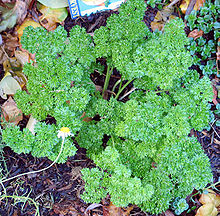Hi everyone!
Everyday we have to check out our herb beds and see what is popping up. A lot of our herbs never really went dormant due to the mild winter we have had. So, we have some life in our beds.
I was out cleaning up the beds a bit and saw all this beautiful green parsley.

We use a lot of parsley around here. And a lot in our herb products.
Parsley (Petroselinum hortense)
Garden parsley is a bright green hairless herbaceous plant in temperate climates, an annual herb in sub-tropical and tropical areas.
Parsley grows best in moist, well drained soil, with full sun. However, the parsley I showed you in the picture is in a rather shaded area. In a good sunny day, it may get only 3-4 hours of sun at the most. So, I guess we are breaking the “sun” rules a bit in our herb bed.
Parsley has many cultivars such as:
Leaf parsley
Parsley plant, Crispum Group
In cultivation, Parsley is subdivided into several cultivar groups depending on the form of the plant, which is related to its end use. These are often treated as botanical varieties but are cultivated selections, not of natural botanical origin.
The two main groups of parsley used as herbs are curly leaf (i,e) (P. crispum Crispum Group; syn. P. crispum var. crispum) and Italian, or flat leaf (P. crispum Neapolitanum Group; syn. P. crispum var. neapolitanum); of these, the Neapolitanum Group more closely resembles the natural wild species. Flat-leaved parsley is preferred by some as it easier to cultivate, being more tolerant of both rain and sunshine, and has a stronger flavor (though this is disputed]), while curly leaf parsley is preferred by others because of its more decorative appearance in garnishing. The produce code for parsley is 4899. A third type, sometimes grown in southern Italy, has thick, celery-like leaf stems.
Root parsley
Root parsley
Another type of parsley is grown as a root vegetable, the Hamburg root parsley (P. crispum Radicosum Group, syn. P. crispum var. tuberosum). This type of parsley produces much thicker roots than types cultivated for their leaves. Although seldom used in Britain and the United States, root parsley is very common in central and eastern European cuisine, where it is used in soups and stews.
Even though root parsley looks similar to the parsnip, it tastes quite different. Parsnips are among the closest relatives of parsley in the family Apiaceae, but the similarity of the names is a coincidence, parsnip meaning "forked turnip"; it is not closely related to real turnips.
Companion plant
Parsley is widely used as a companion plant in gardens. Like many other members of the carrot family (umbellifes), it attracts predatory insects, including wasps and predatory flies to gardens, which then tend to protect plants nearby. For example, they are especially useful for protecting tomato plants as the wasps that kill tomato hornworms also eat nectar from parsley. It offers protection even in its first year as the strong scent of the parsley leaves appear to mingle with the tomato scent and confuses the tomato moth
Parsley is used all around the world as an essential herb. In the culinary world it is used in everything from meat, fish and chicken dishes to soups, stews and salads.
And of course parsley is a big part of the European Bouquet Garni. we have been work on creating a Bouquet Garni to sell at the markets. The hardest part we are dealing with is the proper packaging. I think packaging is always are biggest stumbling block for our products. But, we think this would be a great item for us to sell because it will give the customers all the different herbs at one time without them having to buy them individually. So, folks, we are working on this!
Nutritional value per 100 g (3.5 oz)
| Energy - Sugars Fat Thiamine (vit. B1) Niacin (vit. B3) Vitamin B6 Vitamin C Calcium Magnesium Potassium
| Carbohydrates - Dietary fibre Protein Riboflavin (vit. B2) Pantothenic acid (B5)0.4 mg (8%) Folate (vit. B9) Vitamin K Iron Phosphorus Zinc |
Percentages are relative to US recommendations for adults



I love love love parsley...and eat it straight off the plant! beautiful post and wonderfully informative..fabulous!
ReplyDeletevictoria